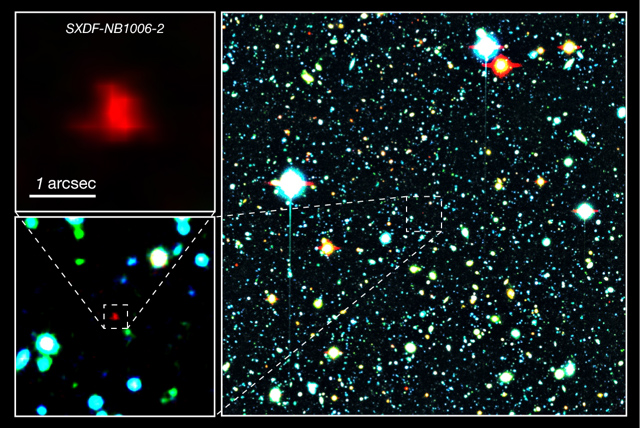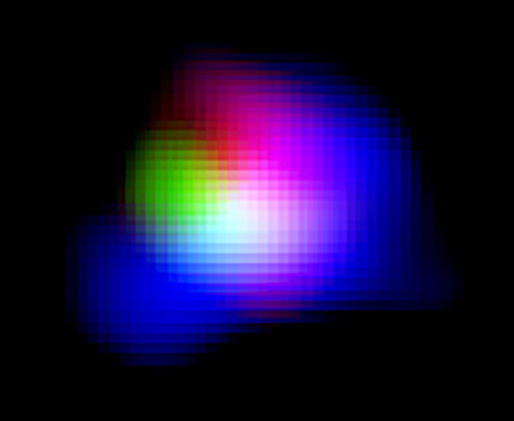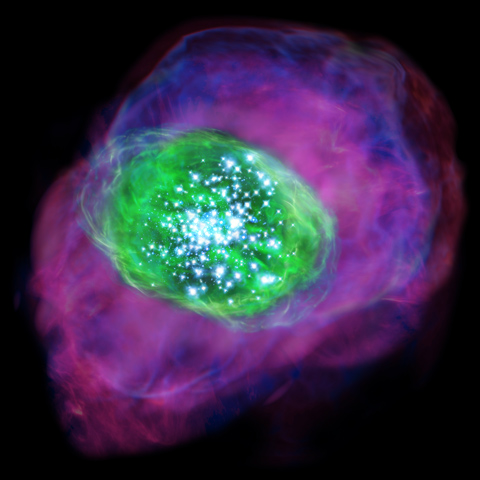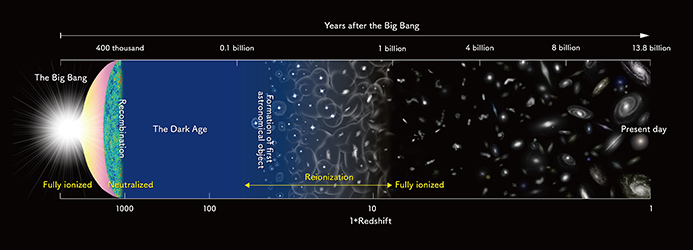ALMA Observes Most Distant Oxygen Ever
16 June, 2016 / Read time: 8 minutes
Astronomers using the Atacama Large Millimeter/submillimeter Array (ALMA), detected a clear signal from oxygen in a galaxy located 13.1 billion light-years away from us. This is the most distant oxygen ever detected. Oxygen in this galaxy seems to be ionized by a number of young giant stars, and this detection is a key step to understand the enigmatic “cosmic reionization” in the early history of the Universe. These observations have opened a new window to probe the early Universe with ALMA.
The research team from Japan, Sweden, the United Kingdom and ESO have used ALMA to observe one of the most distant galaxies known. SXDF-NB1006-2 lies at a redshift of 7.2, meaning that we see it only 700 million years after the Big Bang.
The astronomers hoped to find out about the heavy chemical elements 1 present in the galaxy, as they can tell us about the level of star formation, and hence provide clues about the period in the history of the Universe known as cosmic reionisation.
“Seeking heavy elements in the early Universe is an essential approach to explore the star formation activity in that period,” said Akio Inoue of Osaka Sangyo University, Japan, the lead author of the research paper which is being published in the journal Science on Thursday, June 16, 2016; and added that “Studying heavy elements also gives us a hint to understand how the galaxies were formed and what caused the cosmic reionization”.
Various elements are found around us in the present Universe, but just after the Big Bang, 13.8 billion years ago, only the lightest elements (hydrogen, helium, and lithium) existed. Heavier elements, such as carbon and oxygen, have been formed in stars and accumulated in the Universe over time.
Before the first celestial objects formed, the Universe was filled with electrically neutral gas. Celestial objects emitted strong radiation and started to ionize the neutral gas a few hundred million years after the Big Bang. This is known as cosmic reionization. The state of the whole Universe changed dramatically during this period. But, the process is deeply shrouded in darkness. It has been under debate what kind of objects caused the reionization.

Figure 1. Schematic diagram of the history of the Universe. The Universe is in a neutral state at 400 thousands years after the Big Bang and light from the first generation stars starts to ionize the hydrogen. After several hundred million years, the gas in the Universe is completely ionized. Credit. NAOJ | Download image
“We expected that the light from ionized oxygen is strong enough to be observed, even 13 billion light-years away,” explained Hiroshi Matsuo at the NAOJ, “because the Japanese infrared astronomy satellite AKARI has found that this emission is very bright in the Large Magellanic Cloud, which has an environment similar to the early Universe.”
Nevertheless, the detection of light from ionized oxygen in very distant galaxies was a new challenge for ALMA. To secure the competitive observation time with ALMA, the researchers first performed large-scale computer simulations of the cosmic evolution to predict the emission brightness. “The simulation showed that the light should be particularly bright and easily detected with ALMA,” said Ikkoh Shimizu at Osaka University, the main contributor to this simulation.

Figure 2. Color composite image of a portion of the Subaru XMM-Newton Deep Survey Field. Right panel: The red galaxy at the center of the image is the most distant galaxy, SXDF-NB1006-2. Left panels: Close-ups of the most distant galaxy. Credit: NAOJ | Download image
High sensitivity observations with ALMA were performed in June 2015 and the light from ionized oxygen in SXDF-NB1006-2 was definitively detected 2. This is the most distant detection of oxygen ever achieved and is firm evidence of oxygen in the very early Universe, only 700 million years after the Big Bang. The team estimated that the abundance of oxygen in SXDF-NB1006-2 is ten times smaller than that observed in the Sun.

Figure 3. Color composite image of SXDF-NB1006-2. Light from ionized oxygen detected by ALMA is shown in green. Light from ionized hydrogen detected by the Subaru Telescope and ultraviolet light detected by the UK Infrared Telescope (UKIRT) are shown in blue and red, respectively. Credit: ALMA (ESO/NAOJ/NRAO), NAOJ | Download image
“The small abundance is expected because the Universe was still young and had a short history of star formation at that time,” commented Naoki Yoshida at the University of Tokyo. “In fact, our simulation predicted an abundance ten times smaller than the Sun. But we have another, unexpected, result: a very small amount of dust.”
The observations show that the amount of heavy elements is about 10% of that found in the present Universe, but the amount of dust, which is made from heavy elements, seems to be much smaller. The team was also unable to detect any emissions from carbon in the galaxy. “Something unusual may be happening in this galaxy,” said Inoue. “I suspect that almost all the gas is highly ionized.”

Figure 4. Artist’s concept of SXDF-NB1006-2. Many young bright stars are located in the galaxy and ionize the gas inside and around the galaxy. Green color indicates the ionized oxygen detected by ALMA, whereas purple shows the distribution of ionized hydrogen detected by the Subaru Telescope. Credit: NAOJ | Download image
The emission from ionized oxygen indicates that a number of giant stars, several dozen times heavier than the Sun, have formed in the galaxy and are emitting intense ultraviolet light. The deficits of dust and carbon in the galaxy are crucially important for cosmic reionization to occur. They enable the intense ionizing light to escape from the galaxy and ionize vast amounts of gas outside the galaxy. “SXDF-NB1006-2 would be a prototype of the light sources responsible for the cosmic reionization,” said Inoue.
“This is the first step to understanding what kind of objects caused cosmic reionization,” explained Yoichi Tamura at the University of Tokyo. “Our next observations with ALMA have already started. Higher resolution observations will allow us to see the distribution and motion of ionized oxygen in the galaxy and provide precious information to understand the properties of the galaxy.”
Additional information
These observation results were published online as Inoue et al. “Detection of an oxygen emission line from a high redshift galaxy in the reionization epoch” by the journal Science on Thursday, June 16, 2016
The research team members are:
Akio Inoue (Osaka Sangyo University), Yoichi Tamura (The University of Tokyo), Hiroshi Matsuo (NAOJ/The Graduate University for Advanced Studies), Ken Mawatari (Osaka Sangyo University), Ikkoh Shimizu (Osaka University), Takatoshi Shibuya (The University of Tokyo), Kazuaki Ota (University of Cambridge), Naoki Yoshida (The University of Tokyo), Erik Zackrisson (Uppsala University), Nobunari Kashikawa (NAOJ/The Graduate University for Advanced Studies), Kotaro Kohno (The University of Tokyo), Hideki Umehata (European Southern Observatory/The University of Tokyo), Bunyo Hatsukade (NAOJ), Masanori Iye (NAOJ), Yuichi Matsuda (NAOJ/The Graduate University for Advanced Studies), Takashi Okamoto (Hokkaido University), Yuki Yamaguchi (The University of Tokyo).
This research was supported by the Japan Society for the Promotion of Science through Grants-in-Aid for Scientific Research 26287034, 26247022, 25287050, 24740112, 15H02073, 15K17616 and its Research Fellowship for Young Scientists; The Global COE program “The Next Generation of Physics, Spun from Universality and Emergence” of the Ministry of Education, Culture, Sports, Science and Technology of Japan; the Kavli Institute Fellowship at the Kavli Institute for Cosmology in the University of Cambridge supported by the Kavli Foundation; the Swedish Research 11 Council (project 2011-5349); and the Wenner-Gren Foundation.
The Atacama Large Millimeter/submillimeter Array (ALMA), an international astronomy facility, is a partnership of the European Organisation for Astronomical Research in the Southern Hemisphere (ESO), the U.S. National Science Foundation (NSF) and the National Institutes of Natural Sciences (NINS) of Japan in cooperation with the Republic of Chile. ALMA is funded by ESO on behalf of its Member States, by NSF in cooperation with the National Research Council of Canada (NRC) and the Ministry of Science and Technology (MOST) in Taiwan and by NINS in cooperation with the Academia Sinica (AS) in Taiwan and the Korea Astronomy and Space Science Institute (KASI).
ALMA construction and operations are led by ESO on behalf of its Member States; by the National Radio Astronomy Observatory (NRAO), managed by Associated Universities, Inc. (AUI), on behalf of North America; and by the National Astronomical Observatory of Japan (NAOJ) on behalf of East Asia. The Joint ALMA Observatory (JAO) provides the unified leadership and management of the construction, commissioning and operation of ALMA.
- In astronomical terminology, elements heavier than lithium are collectively dubbed “heavy elements”. ↩
- The original wavelength of the light from doubly ionized oxygen is 88 micrometers. The wavelength of the light from SXDF-NB1006-2 is stretched to 725 micrometers due to the expansion of the Universe, making the light observable with the ALMA Band 8 receivers developed by NAOJ. ↩
Contacts
-
Akio Inoue
Osaka Sangyo University, Osaka, Japan
Email: [email protected]
-
Nicolás Lira
Education and Public Outreach Coordinator
Joint ALMA Observatory, Santiago - Chile
Phone: +56 2 2467 6519
Cel: +56 9 9445 7726
Email: [email protected]
-
Masaaki Hiramatsu
Education and Public Outreach Officer, NAOJ Chile
Observatory, Tokyo - Japan
Phone: +81 422 34 3630
Email: [email protected]
-
Richard Hook
Public Information Officer, ESO
Garching bei München, Germany
Phone: +49 89 3200 6655
Cel: +49 151 1537 3591
Email: [email protected]
-
Charles E. Blue
Public Information Officer
National Radio Astronomy Observatory Charlottesville, Virginia - USA
Phone: +1 434 296 0314
Cel: +1 202 236 6324
Email: [email protected]

